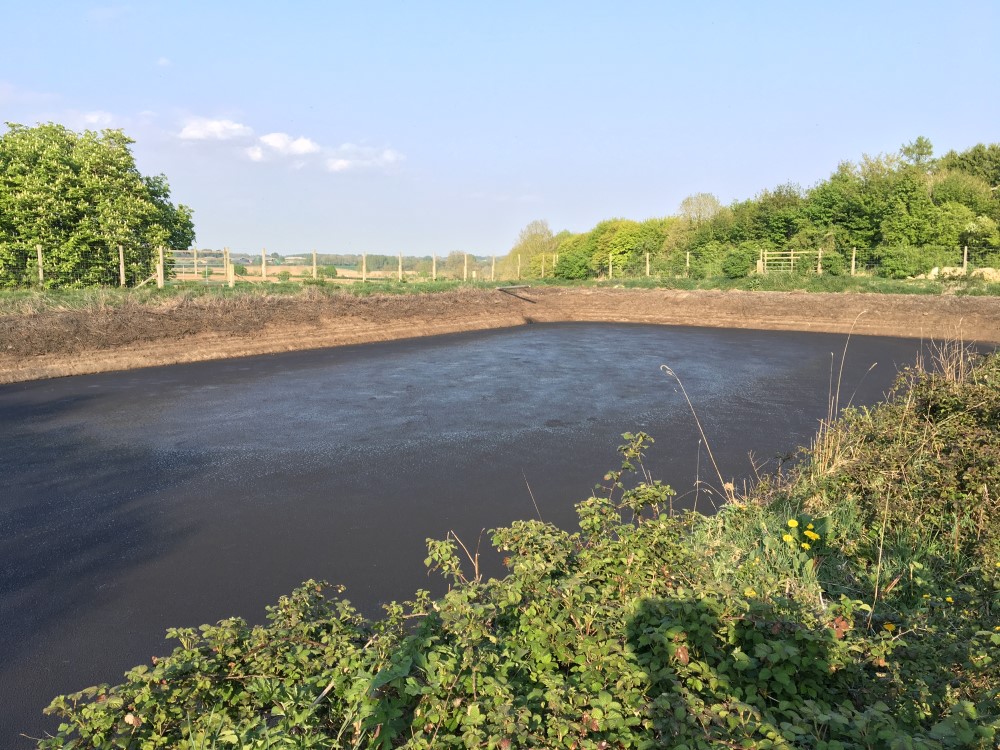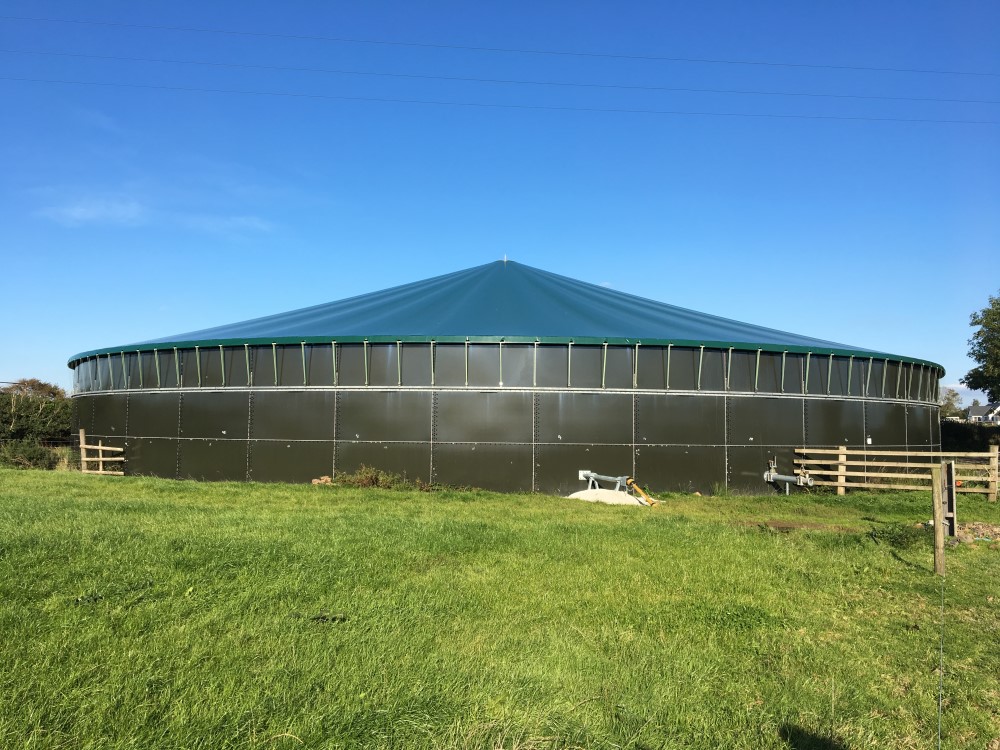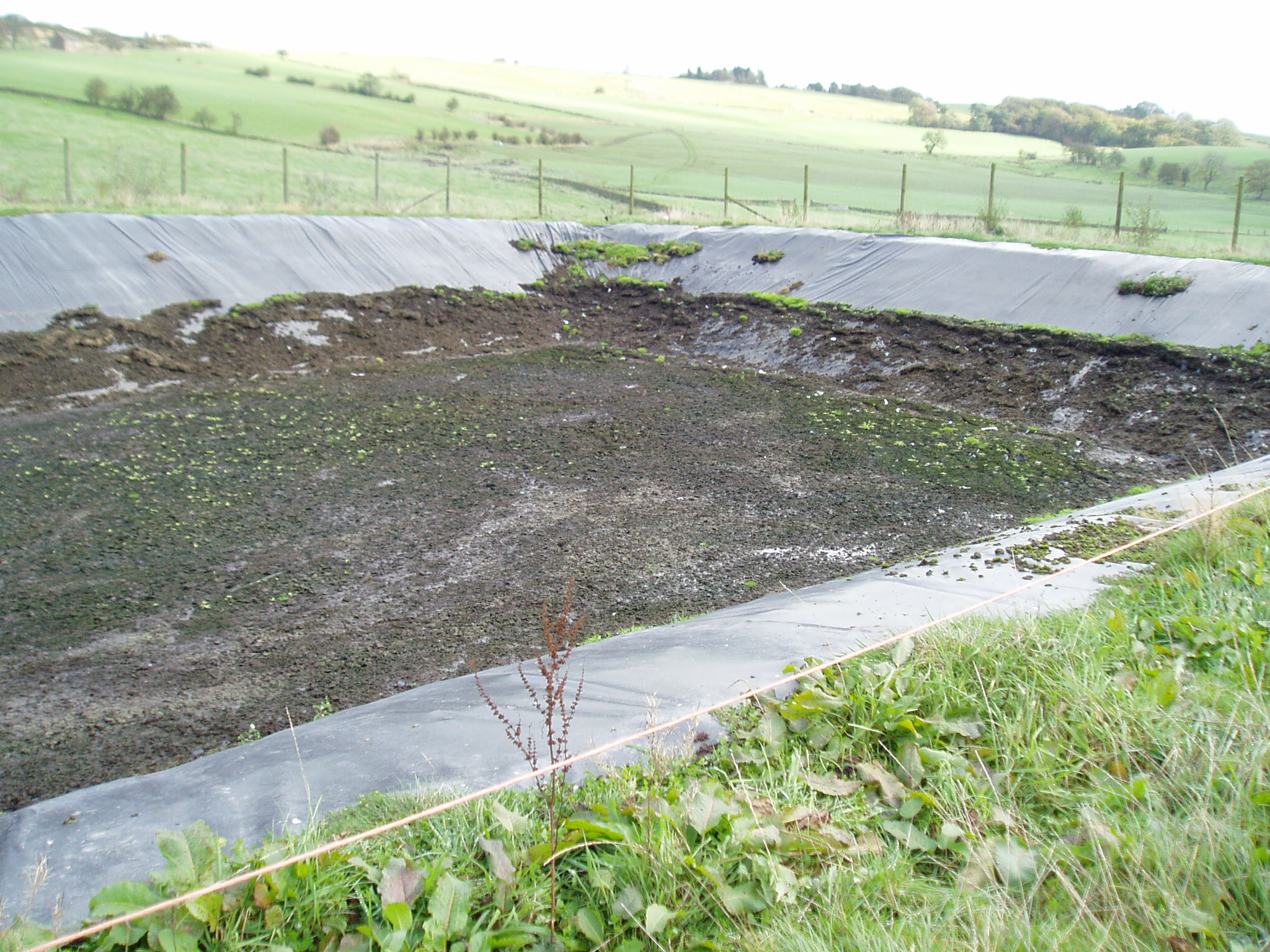- Home
- Knowledge library
- Different types of slurry stores
Different types of slurry stores
There are several slurry storage options available, all of which have their pros and cons.
See below for some of the different options available. More detailed information can be found in the Construction Industry Research and Information Association (CIRIA) guide to Livestock manure and silage storage infrastructure for agriculture.
Earth-banked lagoons
Earth-banked lagoons can be a cost-effective way of storing slurry but are only appropriate to construct in sufficiently impermeable soil. This means that permeability does not exceed 10-9m/s, typically with a clay content of 20–30% and with sufficient material to ensure there is an impermeable layer at least 1 m thick. Soils can be lab-tested to determine permeability. It requires a 750 mm freeboard.

|
Positives |
Negatives |
|
Cheapest form of storage to construct |
Surface to volume ratio is high, so it will collect a lot of rainwater |
|
Simple approach |
Large lagoons can be difficult to agitate, making it hard to present slurry in a suitable condition for spreading |
|
Versatile – easily extended, capable of storing slurries of different DM content |
Occupies large land area |
|
Repair and maintenance is inexpensive |
Requires suitable soil type and low water table |
|
Structure life will easily exceed 20 years if maintained properly |
Vulnerable to damage by vegetation and burrowing mammals |
|
|
Machinery operation can damage lagoon’s structural integrity |
|
|
Leak detection systems are difficult to fit and often unsatisfactory |
|
|
Difficult to cover with impermeable material |
Lined earth-banked lagoons
Lined lagoons function like an earth-banked lagoon but can be used where the permeability requirements (for earth banked lagoons) cannot be met. A synthetic sheet, secondary liner or imported clay interior liner can be used within an earth-banked lagoon to make a lined lagoon. It requires a 750 mm freeboard.
|
Positives |
Negatives |
|
Relatively cheap form of storage compared to concrete or steel |
Surface-to-volume ratio is high, so it will collect a lot of rainwater |
|
Liner allows storage in permeable soils |
Large lagoons can be difficult to agitate, making it hard to present slurry in a suitable condition for spreading |
|
Liner can be combined with access ramps and concrete flooring, which increases the range of material that can be stored |
Occupies large land area |
|
|
Liner is vulnerable to damage, especially when emptying |
|
|
Synthetic liners will have a limited lifespan |
|
|
Vulnerable to damage by vegetation and burrowing mammals |
|
|
Machinery can damage lagoon’s structural integrity |
|
|
Leak detection systems needed |
|
|
Unsuitable for areas with high water table as liner will float on groundwater |
Above-ground tanks
An above-ground tank can be used in areas where a lagoon may not be appropriate such as where land may have a high-water table or where the land availability is limited. This option is more expensive than earth-banked lagoons.
Above-ground tanks will usually require a reception pit where the slurry can be scraped to a transfer pump to mix and lift the slurry into the store.

|
Positives |
Negatives |
|
They are tall structures with minimal land take, so there is less surface area to collect rainfall, lowering spreading costs and capacity requirements |
Reliant on pumps so not suitable for manures with high dry matter content |
|
Depending on structural requirements, they can be fairly simple to extend. This will increase capacity without increasing footprint |
Complex pumping system will increase the possibility of mechanical failure |
|
Relatively inexpensive and simple to cover |
Costs more than earth-banked lagoons |
|
Suitable for high water table areas |
No safe access inside so unsuitable for bedding that settles |
|
Regular maintenance is inexpensive |
Synthetic liners will have a limited lifespan |
|
Periodic refurbishment such as resealing, re-bolting or replacement of panels is possible |
Danger of impact damage |
Concrete stores
Concrete stores are constructed from reinforced concrete panels or mass-poured. These types of stores can be constructed above or below ground level, and filling can be done by pump, gravity discharge or mechanical scraper.
|
Positives |
Negatives |
|
They are tall structures with minimal land take, so there is less surface area to collect rainfall, lowering spreading costs and capacity requirements |
Reliant on pumps so not suitable for manures with high dry matter content |
|
Depending on structural requirements, they can be fairly simple to extend. This will increase capacity without increasing footprint |
Complex pumping system will increase the possibility of mechanical failure |
|
Relatively inexpensive and simple to cover |
Costs more than earth-banked lagoons |
|
Suitable for high water table areas |
No safe access inside so unsuitable for bedding that settles |
|
Regular maintenance is inexpensive |
Synthetic liners will have a limited lifespan |
|
Periodic refurbishment such as resealing, re-bolting or replacement of panels is possible |
Danger of impact damage |
Underfloor slatted stores
An underfloor slatted store will sit underneath part of the housed livestock building. This is typically in areas where the livestock circulate or under feeding areas. It will usually only receive the manure from the housed livestock and little to no rainfall. It is typically constructed with poured concrete to minimise the risk of leakage. The design requires a minimum of 300 mm freeboard.
|
Positives |
Negatives |
|
Usually underground but can be above natural ground level |
May require access to remove solids |
|
Periodically emptied by pump |
There will be health and safety issues if entering an enclosed store |
|
Little maintenance needed |
|
|
Range of construction materials available |
|
|
Suitable for most bedding types except chopped straw and sand |
|
Weeping wall stores
Weeping wall storage provides separation of slurries as well as storage. It typically consists of a concrete floor with one or more semi-permeable walls. The walls allow the liquid part of the slurry to drain out and be collected into an additional store. The retained solids can be removed via a ramp, lift out panels or excavator. The liquid collected from the weeping wall is classified as slurry and is subject to standard regulations and requirements.
|
Positives |
Negatives |
|
Size and shape can be designed to suit site layout |
Suitable for only a limited range of slurry DM types |
|
Separates slurry into pumpable liquid and semi-solid manure for ease of spreading |
Construction cost is high |
|
Covering is possible with ease depending on size and shape |
Repairs to concrete panels can be expensive |
|
Maintenance costs are generally low |
|
|
Generally hardwearing, moderately vulnerable to damage |
|
|
Not dependent on soil type or water table |
|
|
Store is long lasting providing panels do not get damaged |
|
Slurry bags
Slurry bags are a less common form of storage. They can be as large as 7000 m3 and are constructed with reinforced impermeable artificial membranes such as PVC. They can be fitted with several inlets to facilitate emptying and filling. They can also incorporate electric or hydraulic agitators. They are only suitable for slurries that are pumpable but are highly effective at capturing and containing ammonia emissions.
|
Positives |
Negatives |
|
Similar cost to concrete or steel storage |
May need additional support structure or secondary containment (such as a lined lagoon) |
|
Highly effective at stopping nitrogen loss in the form of ammonia emissions |
A leak detection system will likely be required |
|
Possible to incorporate stirrers |
Synthetic liner has a limited lifespan (around 20 years) and can be damaged by exposure to light and extreme temperature |
|
Excludes rainwater |
Only suitable for pumpable slurries (solid-free) |
|
Minimal maintenance required |
Moderate to high land take |
|
|
Less suitable for areas with a high water table |
|
|
Bunding required in case of split |
|
|
Vulnerable to damage by mammals, so must be fenced off from livestock |


